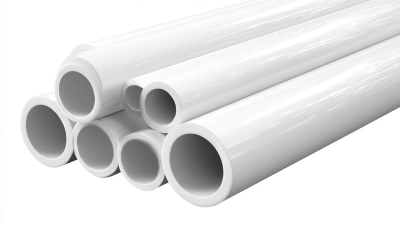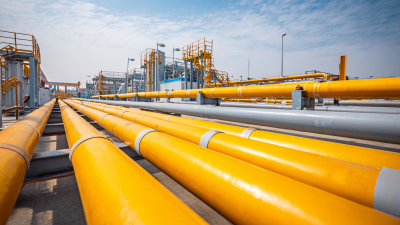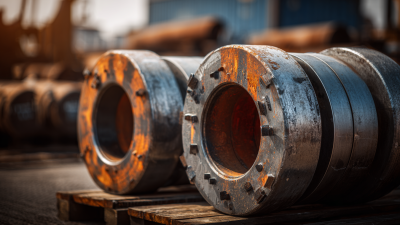Email Id: sale@adctooling.com
In the realm of industrial applications, the selection of the appropriate valve type is critical for ensuring efficiency and safety in fluid management systems. Among the various options available, ball valves stand out for their versatility and reliability, making them a popular choice across diverse sectors. According to a report by MarketsandMarkets, the global ball valve market was valued at approximately $11.3 billion in 2020 and is projected to reach $15.8 billion by 2026, growing at a CAGR of 5.5%. This growth underscores the increasing reliance on ball valves in oil & gas, chemical processing, and water treatment industries, where precise control of fluid flow is essential. This blog will provide a comprehensive comparison of different ball valve types, exploring their unique features, advantages, and optimal applications in industrial settings to guide professionals in making informed decisions tailored to their operational needs.

When selecting a ball valve for industrial applications, understanding the differences between full-port and reduced-port ball valves is essential for optimal performance. Full-port ball valves feature a larger opening that matches the line diameter, allowing for greater flow capacity and minimal pressure drop. This design makes them ideal for applications requiring unrestricted flow, such as in water treatment, oil and gas sectors, and processes where consistency and efficiency are paramount. Their ability to handle high flow rates without significant turbulence makes them versatile in demanding environments.

On the other hand, reduced-port ball valves have a smaller opening that is significantly narrower than the pipe diameter. This design often results in a more compact size and lower cost, which can be beneficial for applications where space and budget constraints are a priority. However, the reduced flow capacity may introduce more pressure drop, making them less suitable for high-volume applications. They work well in simple on/off control applications where the exact flow rate is not critical. By carefully considering the specific needs of your industrial process, you can select the right valve type to ensure reliability and efficiency in your system.
When it comes to high-pressure systems, choosing the right valve can greatly influence performance and safety. Trunnion-mounted ball valves have emerged as a preferred choice for such applications. Unlike traditional floating ball valves, trunnion-mounted designs feature a fixed shaft that supports the ball, significantly reducing the wear and tear on the valve’s seat. This advantage becomes particularly valuable in high-pressure scenarios, where the risk of leaking and failure can lead to substantial operational setbacks.
Another critical benefit of trunnion-mounted ball valves is their ability to maintain a consistent performance across a wide range of pressures. Their design allows for minimal torque during operation, which means they are easier to control, even under extreme conditions. Additionally, the stability offered by the trunnion mount helps prevent any movement of the ball, leading to improved sealing performance and longevity. These factors collectively make trunnion-mounted ball valves an optimal choice for industries that require reliable and efficient flow control in high-pressure environments.
 Floating ball valves have gained popularity across various industries due to their remarkable performance versatility. Unlike fixed ball valves, floating ball valves are designed with a ball that is not anchored, allowing it to float and create a tight seal as the valve closes. This design is particularly effective in handling low to medium pressure applications, showcasing a unique advantage in industries such as oil and gas, water treatment, and chemical processing. According to a recent report by MarketsandMarkets, the ball valve market is projected to reach USD 10.85 billion by 2025, driven largely by the increasing demand for floating ball valves.
Floating ball valves have gained popularity across various industries due to their remarkable performance versatility. Unlike fixed ball valves, floating ball valves are designed with a ball that is not anchored, allowing it to float and create a tight seal as the valve closes. This design is particularly effective in handling low to medium pressure applications, showcasing a unique advantage in industries such as oil and gas, water treatment, and chemical processing. According to a recent report by MarketsandMarkets, the ball valve market is projected to reach USD 10.85 billion by 2025, driven largely by the increasing demand for floating ball valves.
When selecting floating ball valves for industrial applications, it’s essential to consider the material of construction. For instance, stainless steel valves offer excellent corrosion resistance, making them ideal for harsh environments. Additionally, a valve's size and pressure rating are critical factors that can influence performance and longevity. Always consult manufacturer specifications and industry standards to ensure optimal compatibility with your system.
Tip: Regular maintenance of floating ball valves can significantly enhance their lifespan. Implement a scheduled inspection to identify wear and tear early, and avoid costly downtime. Also, consider the fluid characteristics in your system, as they can affect the valve’s performance; selecting the right valve type will ensure seamless operation across diverse applications.
When considering the optimal material for ball valves in industrial applications, the choice among brass, stainless steel, and PVC can significantly impact functionality and durability. Brass ball valves, often favored for their cost-effectiveness and excellent corrosion resistance, are, however, facing scrutiny due to lead leaching potential. Recent findings indicate that the lead levels in new brass plumbing devices may exceed 300 μg/L, raising concerns about drinking water safety. This has prompted many industries to reconsider their material selection, particularly in critical applications.
On the other hand, stainless steel valves offer superior strength and excellent corrosion resistance, making them ideal for harsh environments. In the irrigation valves market, metal valves, including stainless steel options, accounted for a substantial 67.9% share in 2024. This dominance is attributed to their reliability and long service life, proving essential for continuous water flow in irrigation systems.
When choosing a ball valve material, consider the following tips:
- Assess the specific environmental conditions your valves will face, including temperature and corrosion potential.
- Keep an eye on recent reports regarding safety standards, especially for brass valves, to ensure compliance and safety in applications involving potable water.
- Balance cost, durability, and safety when selecting materials, taking into account both initial investment and long-term maintenance costs.
The role of automation in optimizing ball valve types has grown increasingly significant as industries seek enhanced efficiency and reliability in fluid control systems. Automated ball valves, equipped with smart technology, provide precise control over flow rates and reduce the risk of human error. According to a recent report by Global Market Insights, the automation of valves, including ball valves, is projected to grow at a compound annual growth rate (CAGR) of over 8% from 2021 to 2027. This growth is driven by the demand for improved operational efficiency and reduced downtime in various sectors, including oil and gas, water treatment, and chemical processing.
Furthermore, the integration of automation in ball valve operations allows for real-time monitoring and diagnostics, significantly boosting productivity. A study by Research and Markets indicates that automated control systems in valve applications can lower maintenance costs by up to 20%, thereby enhancing overall system performance. The ability to quickly adapt to changing process conditions with automated ball valves not only improves response times but also contributes to energy savings and reduced wastage. This technological advancement positions automated ball valves as a critical component for industries aiming to optimize their operations and achieve sustainable growth in a competitive landscape.
| Ball Valve Type | Operating Pressure (psi) | Temperature Range (°F) | Material | Automation Capability | Applications |
|---|---|---|---|---|---|
| Standard Ball Valve | 150-300 | -20 to 150 | Carbon Steel | Available | Water, Oil, Gas |
| Trunnion Ball Valve | 500-600 | -50 to 300 | Stainless Steel | Highly Recommended | Refineries, Power Plants |
| Floating Ball Valve | 150-600 | -20 to 180 | Brass | Available | Chemical, Food Grade |
| Electric Ball Valve | 150-1500 | -40 to 180 | PVC | Fully Automated | Wastewater, HVAC |
| Manual Ball Valve | 50-300 | -10 to 140 | Aluminium | Not Applicable | Domestic, Landscaping |





